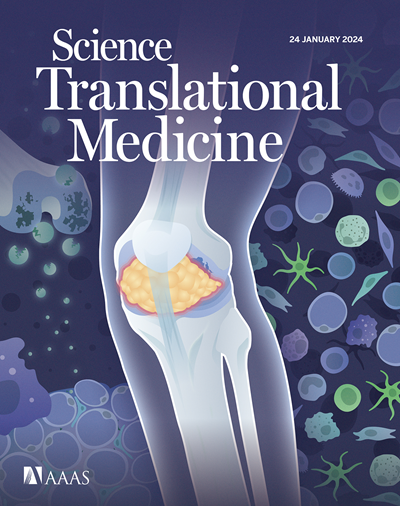Gluconolactone restores immune regulation and alleviates skin inflammation in lupus-prone mice and in patients with cutaneous lupus
IF 15.8
1区 医学
Q1 CELL BIOLOGY
Science Translational Medicine
Pub Date : 2025-02-19
引用次数: 0
Abstract
Systemic lupus erythematosus (SLE) is characterized by dysfunctional regulatory T cells (Tregs). We previously showed that protein phosphatase 2A (PP2A) plays a critical role in maintaining the suppressive function of Tregs. Here, we analyzed phosphoproteomics and metabolomics data from PP2A–wild type and PP2A-deficient Tregs and demonstrated that PP2A regulates Treg function through the pentose phosphate pathway (PPP). Furthermore, we proved that the PPP metabolite gluconolactone (GDL) enhances in vitro induced (i)Treg differentiation and function by promoting forkhead box protein 3 and phosphorylated signal transducer and activator of transcription 5 expression and inhibits T helper 17 (TH17) differentiation in murine cells. In short-term imiquimod-induced autoimmunity in mice, treatment with GDL alleviates inflammation by inhibiting TH17 cells. GDL promotes Tregs function and alleviates skin lesions in MRL.lpr lupus-prone mice in vivo. It also promotes Tregs differentiation and function in ex vivo experiments using cells from patients with SLE. Last, in patients suffering from cutaneous lupus erythematosus, topical application of a GDL-containing cream controlled skin inflammation and improved the clinical and histologic appearance of the skin lesions within 2 weeks. Together, we have identified GDL as a PPP metabolite and showed mechanistically that it restores immune regulation in vitro and in vivo by inducing Treg suppressive function and inhibiting TH17 cells. GDL should be considered as a treatment approach for inflammatory and autoimmune diseases.

求助全文
约1分钟内获得全文
求助全文
来源期刊

Science Translational Medicine
CELL BIOLOGY-MEDICINE, RESEARCH & EXPERIMENTAL
CiteScore
26.70
自引率
1.20%
发文量
309
审稿时长
1.7 months
期刊介绍:
Science Translational Medicine is an online journal that focuses on publishing research at the intersection of science, engineering, and medicine. The goal of the journal is to promote human health by providing a platform for researchers from various disciplines to communicate their latest advancements in biomedical, translational, and clinical research.
The journal aims to address the slow translation of scientific knowledge into effective treatments and health measures. It publishes articles that fill the knowledge gaps between preclinical research and medical applications, with a focus on accelerating the translation of knowledge into new ways of preventing, diagnosing, and treating human diseases.
The scope of Science Translational Medicine includes various areas such as cardiovascular disease, immunology/vaccines, metabolism/diabetes/obesity, neuroscience/neurology/psychiatry, cancer, infectious diseases, policy, behavior, bioengineering, chemical genomics/drug discovery, imaging, applied physical sciences, medical nanotechnology, drug delivery, biomarkers, gene therapy/regenerative medicine, toxicology and pharmacokinetics, data mining, cell culture, animal and human studies, medical informatics, and other interdisciplinary approaches to medicine.
The target audience of the journal includes researchers and management in academia, government, and the biotechnology and pharmaceutical industries. It is also relevant to physician scientists, regulators, policy makers, investors, business developers, and funding agencies.
 求助内容:
求助内容: 应助结果提醒方式:
应助结果提醒方式:


